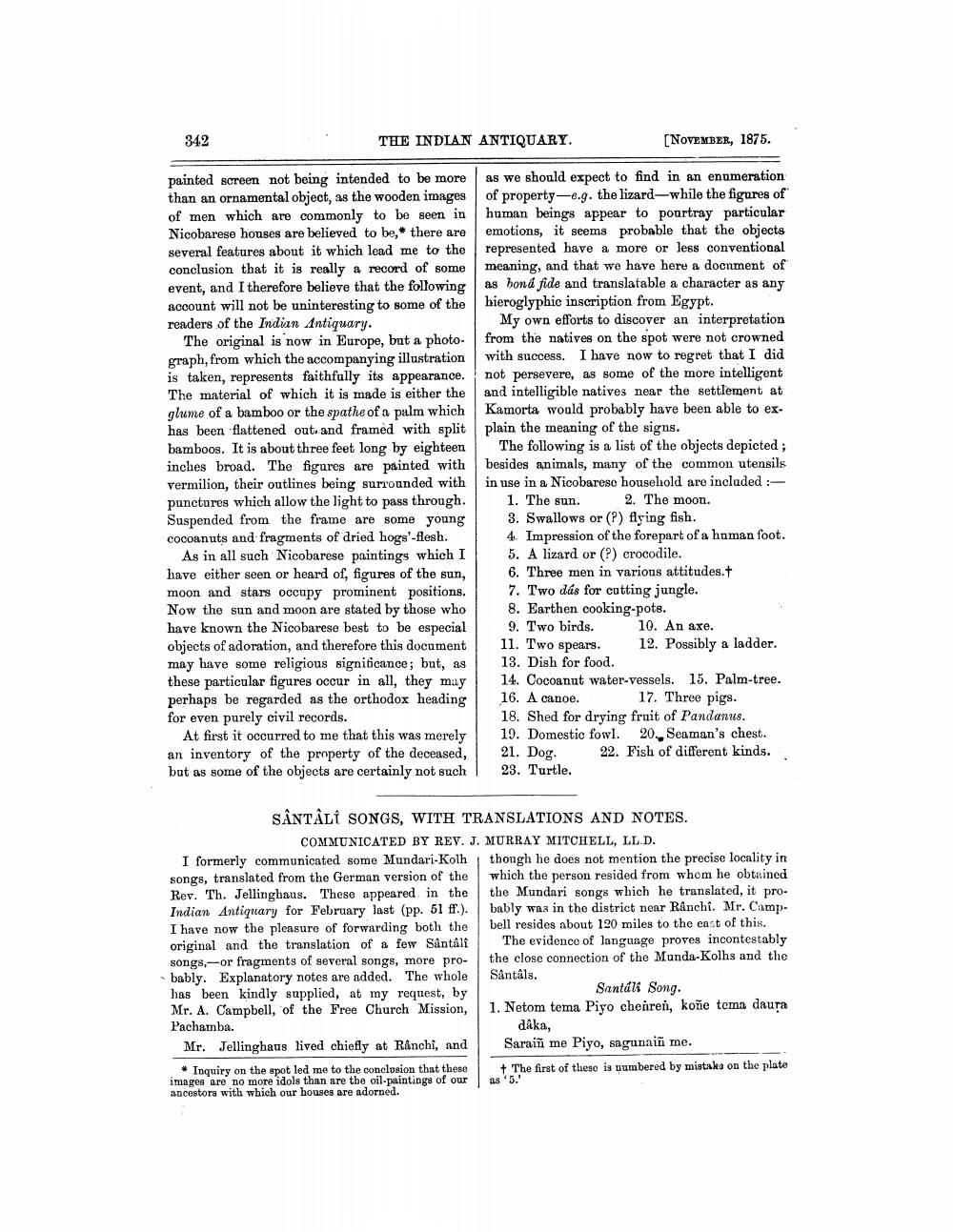________________
342
THE INDIAN ANTIQUARY.
painted screen not being intended to be more than an ornamental object, as the wooden images of men which are commonly to be seen in Nicobarese houses are believed to be, there are several features about it which lead me to the conclusion that it is really a record of some event, and I therefore believe that the following account will not be uninteresting to some of the readers of the Indian Antiquary.
The original is now in Europe, but a photo graph, from which the accompanying illustration is taken, represents faithfully its appearance. The material of which it is made is either the glume of a bamboo or the spathe of a palm which has been flattened out and framed with split bamboos. It is about three feet long by eighteen inches broad. The figures are painted with vermilion, their outlines being surrounded with punctures which allow the light to pass through. Suspended from the frame are some young cocoanuts and fragments of dried hogs'-flesh.
As in all such Nicobarese paintings which I have either seen or heard of, figures of the sun, moon and stars occupy prominent positions. Now the sun and moon are stated by those who have known the Nicobarese best to be especial objects of adoration, and therefore this document may have some religious significance; but, as these particular figures occur in all, they may perhaps be regarded as the orthodox heading for even purely civil records.
At first it occurred to me that this was merely an inventory of the property of the deceased, but as some of the objects are certainly not such
[NOVEMBER, 1875.
as we should expect to find in an enumeration of property-e.g. the lizard-while the figures of human beings appear to pourtray particular emotions, it seems probable that the objects represented have a more or less conventional meaning, and that we have here a document of as bond fide and translatable a character as any hieroglyphic inscription from Egypt.
I formerly communicated some Mundari-Kolh songs, translated from the German version of the Rev. Th. Jellinghaus. These appeared in the Indian Antiquary for February last (pp. 51 ff.).. I have now the pleasure of forwarding both the original and the translation of a few Sântâli songs,-or fragments of several songs, more probably. Explanatory notes are added. The whole has been kindly supplied, at my request, by Mr. A. Campbell, of the Free Church Mission, Pachamba.
Mr. Jellinghaus lived chiefly at Rânchi, and
Inquiry on the spot led me to the conclusion that these images are no more idols than are the oil-paintings of our ancestors with which our houses are adorned.
My own efforts to discover an interpretation from the natives on the spot were not crowned with success. I have now to regret that I did not persevere, as some of the more intelligent and intelligible natives near the settlement at Kamorta would probably have been able to explain the meaning of the signs.
The following is a list of the objects depicted; besides animals, many of the common utensils in use in a Nicobarese household are included :2. The moon.
1. The sun.
3. Swallows or (?) flying fish.
4. Impression of the forepart of a human foot. 5. A lizard or (?) crocodile.
6. Three men in various attitudes.+ 7. Two dás for cutting jungle. 8. Earthen cooking-pots.
9. Two birds.
11. Two spears. 13. Dish for food.
14. Cocoanut water-vessels. 16. A canoe.
17. Three pigs.
18. Shed for drying fruit of Pandanus. 19. Domestic fowl. 20. Seaman's chest. 21. Dog. 22. Fish of different kinds.
23. Turtle.
SANTALI SONGS, WITH TRANSLATIONS AND NOTES. COMMUNICATED BY REV. J. MURRAY MITCHELL, LL.D.
10. An axe.
12. Possibly a ladder.
15. Palm-tree.
though he does not mention the precise locality in which the person resided from whom he obtained the Mundari songs which he translated, it probably was in the district near Rânchi. Mr. Campbell resides about 120 miles to the east of this.
The evidence of language proves incontestably the close connection of the Munda-Kolhs and the Sântâls.
Santali Song. 1. Netom tema Piyo cheiren, koñe tema dauṛa dâka,
Sarain me Piyo, sagunain me.
+ The first of these is numbered by mistake on the plate as 5.'




